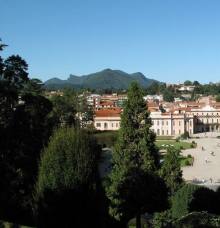
- GOLF
- LAKES, FALLS, BEACHES
- MUSEUMS
- ROCCHE, CASTELLI, FORTIFICAZIONI
- CHIESE, SANTUARI, LUOGHI E PERCORSI SACRI
- VILLE E PALAZZI
- PARCHI, RISERVE NATURALI, ORRIDI
- ISLANDS
attraction Varese
Palazzo Estense and gardens
Palazzo Estense earned the nickname in Varese of Versailles of Milan (given to it by Stendhal) and is a masterpiece by architect Giuseppe Bianchi. It is on Via Sacco, just a short distance from the town centre.
Palazzo Estense: history
Palazzo Estense was built between 1766-1771 on the will of Duke of Modena Francesco III d’Este who, having obtained the Seigniory of Varese from Maria Theresa of Austria, wanted his court to be here. The duke had purchased the building in 1765, when it was still Tommaso Orrigoni’s villa.
Architect Giuseppe Bianchi added two large wings to the original U-shaped layout characterising Villa Orrigoni. The building and garden (completed in 1787) were renovated based on Bianchi’s drawings. Inspired by the Viennese imperial residence in Schönbrunn, he created one of the most interesting 18th-century gardens in all of Lombardy. The majestic fountain in the square in front of the building, just after the parterre, is the ideal focal point of the garden which, animated by downward slopes, panoramic viewpoints, paths with hornbeams, walks and multicoloured flower beds can rightfully be considered one of the most charming Italian public parks. The top of the hill offers a broad panoramic view over the city of Varese.
The Estensi gardens are considered the most significant element in the complex, and merge uninterruptedly on the bottom with the park at Villa Mirabello.
Outside…
The almost anonymous façade facing the city centre decidedly contrasts with the building’s more interesting façade turned towards the garden. Shapes are moderate, typical of Lombard Rococo style, with a neoclassical influence, and pilasters and white stringcourses stand out against pink plaster. There is a sundial under the ducal eagle on the pediment.
... and inside Palazzo Estense
Salone Estense (also known as Salone d’onore or Hall of Honour) on the ground floor is quite impressive with its illusionistic architecture painted by Bosellini and the great centre medallion frescoed by Giovan Battista Ronchelli. Entering the hall, one’s eye is attracted by the large multicoloured-marble fireplace and elegant crystal chandeliers. The hall is often used for conferences or concerts.
Going up to the first floor, visitors encounter 4 niches with female busts from the 18th century and several original lamp-holders with stucco cupids. Looking up is another medallion by Ronchelli (in poor condition) depicting the withdrawal of Francesco III d’Este in Varese. On the first floor is the Sala da Ballo (Dance Hall) decorated with 16th- & 17th-century canvases, including the Virgin with Child from the School of Morazzone.
The building is currently the seat of the Town Hall and home to the civic library.
Photo gallery Palazzo Estense and gardens







Follow @LagoMaggioreNet